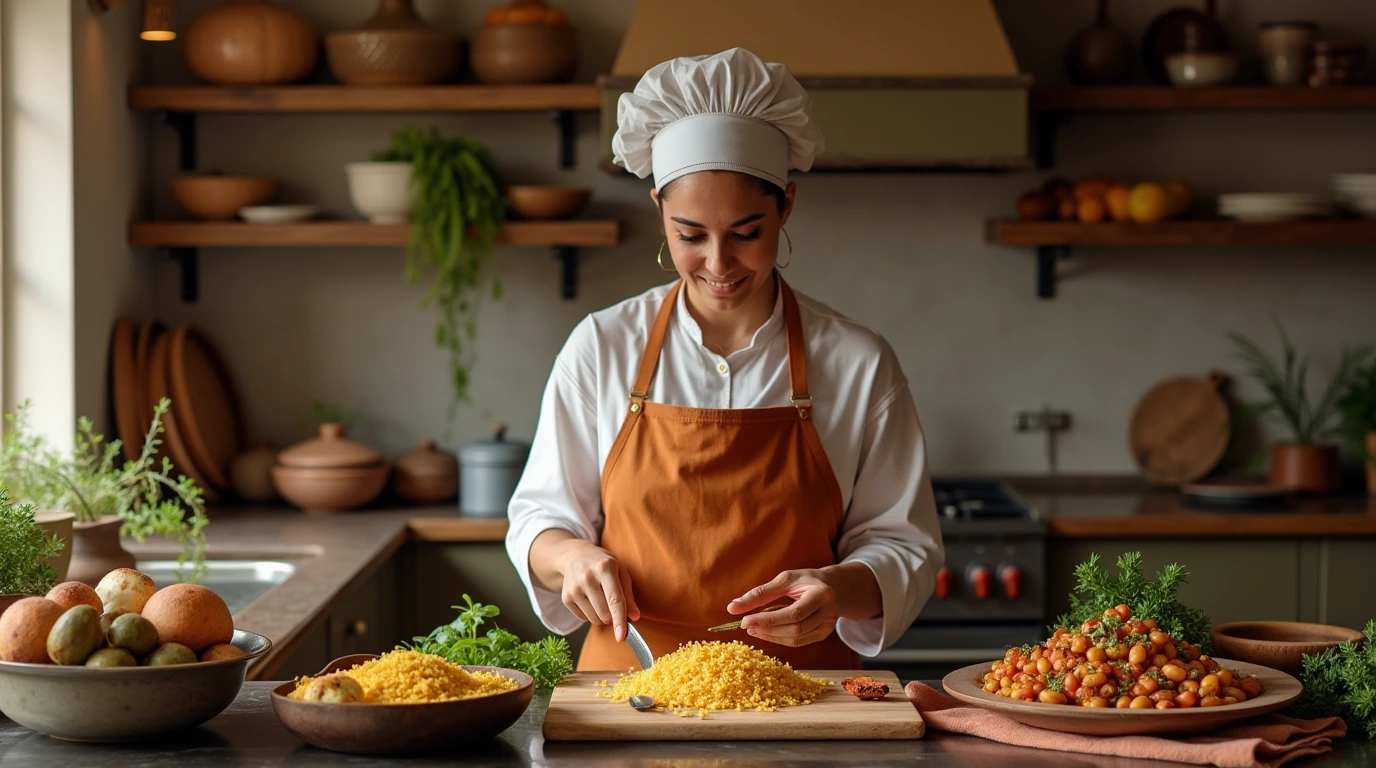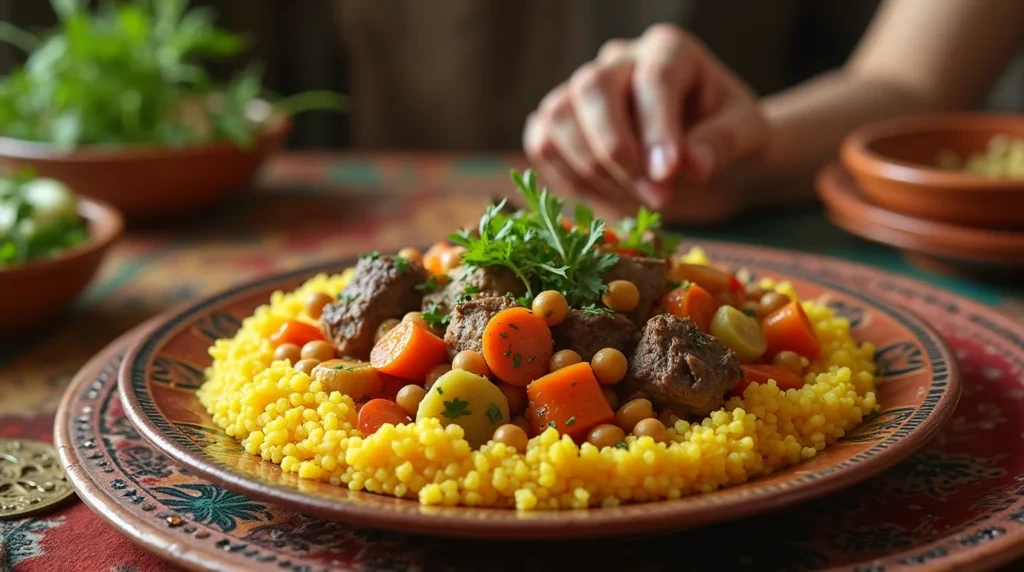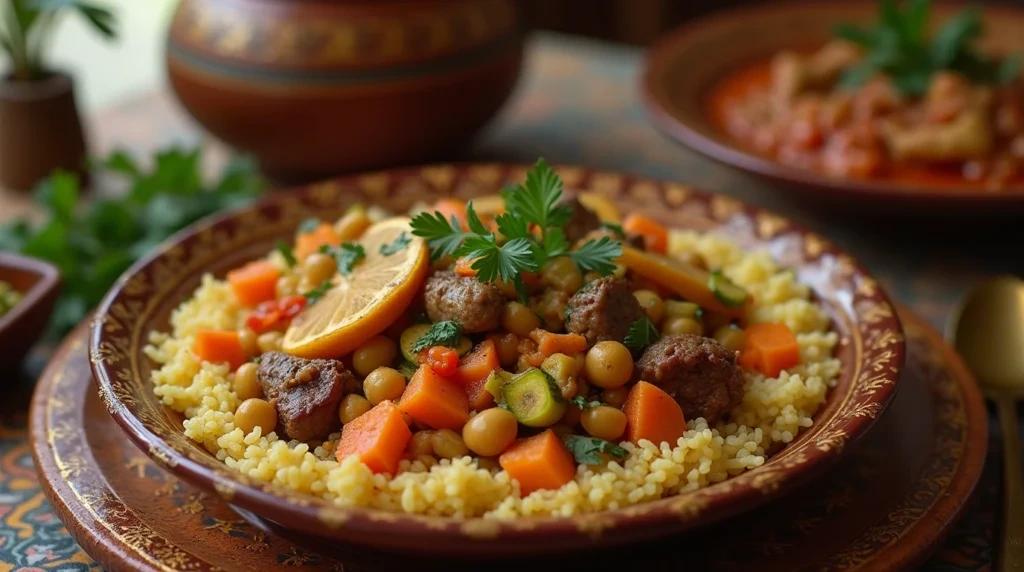Our Location
304 North Cardinal St.
Dorchester Center, MA 02124

Couscous Moroccan Dish is more than food; it’s a celebration of North African culture. It’s a key part of family and festive events, loved for centuries. This grain, with its mix of spices and fresh ingredients, suits both old and new tastes.

Discover seven recipes that show couscous’s wide appeal. From veggie-packed dishes to meaty ones, each recipe is a story. Spices like cumin and ras el hanout add depth, making couscous a true art form in Moroccan cooking.
Couscous is more than just a grain in Moroccan culture. It’s a key part of their identity. For centuries, moroccan dishes with couscous have shown unity, tradition, and hospitality. They reflect Morocco’s rich culinary history.

Couscous comes from Berber communities and is over 2,000 years old. UNESCO has recognized it as Intangible Cultural Heritage. Its journey from food to cultural icon shows Morocco’s history.
Berber women used to spend hours hand-rolling semolina grains. This tradition is still kept alive in rural areas today.
Preparing couscous needs special tools like the couscousier (dual-layer pot) and gesra (wooden tray). These tools help make the dish authentic. Here’s how they help:
| Utensil | Purpose |
|---|---|
| Couscoussier | Steams couscous over stew, infusing flavor |
| Gesra | Hand-rolls semolina into fine grains |
In Moroccan homes, couscous dish morocco is a time for everyone to come together. Families gather around a shared platter. They use their hands to mix grains with stew—no utensils needed.
This tradition, often on Fridays, brings people closer. Elders eat first, showing respect and unity.
Making a true moroccan couscous dish begins with the right ingredients. The couscous grains come in different textures. Fine grains are best for salads, while coarse ones are better for stews.
Traditional recipes often use hand-rolled grains. But, many cooks today prefer pre-steamed couscous for its convenience.

Spices like cumin and ras el hanout boost the flavors. Olive oil helps everything come together. Preserved lemons need weeks in saltwater to get their unique taste.
Dried fruits like raisins or figs add sweetness to festive versions. They balance out the savory flavors.
Using high-quality semolina is key to keep the couscous fluffy. Always soak the grains before cooking to avoid clumps. For a true moroccan couscous, skip pre-flavored mixes and use fresh ingredients for the best taste.
Every spoonful of couscous moroccan dishes is rich thanks to a special spice mix. These seven ingredients turn simple grains into a flavorful masterpiece. They make the dish famous around the world.
Ras el Hanout is a mix of up to 30 spices, like cardamom, nutmeg, and turmeric. Home cooks often use a simpler blend of cumin, coriander, and paprika. Its floral scents are perfect for slow-cooked moroccan dish with couscous recipes.
Cumin brings a smoky taste, coriander adds a citrusy note, and cinnamon is sweet. Grind these spices fresh for the best flavor. This trio is the foundation of most couscous moroccan dishes.
Harissa chili paste adds a spicy kick without overpowering other tastes. Cooks balance it with mild paprika or cayenne. A pinch of caraway seeds adds depth to traditional recipes.
Brined lemons add a tangy flavor to meat-based couscous dishes. Fresh cilantro and parsley add a bright touch. Saffron threads sometimes make special-occasion meals even more special.
Couscous with vegetables is a dish from Morocco. It has seven vegetables, each picked for its taste and meaning. This dish, called Couscous Bidaoui, includes turnips, carrots, zucchini, pumpkin, cabbage, chickpeas, and onions. These foods show the harvests and meals shared by the community. The number seven is special in Moroccan culture, meaning everything is complete.
Present the couscous in a central bowl, with vegetables arranged like a garden. Serve with:
Traditionally, diners use their hands to mix the grains with broth. This practice honors the dish’s communal roots.
The couscous moroccan dish with lamb and caramelized onions is a key part of Moroccan feasts. It combines rich flavors in a process that requires patience and care. The moroccan couscous is made with lamb shoulder or leg, simmered until it’s very tender. It’s flavored with saffron, ginger, and turmeric for extra depth.
Layering is crucial: start with fluffy couscous, then add the braised lamb. Finally, top it with caramelized onions cooked with cinnamon, honey, and raisins. This creates a dish where sweet and savory flavors come together, showing off Morocco’s culinary skill.
| Layer | Component | Details |
|---|---|---|
| 1 | Couscous | Steamed with butter and broth |
| 2 | Lamb | Cooked in a tagine until fork-tender |
| 3 | Onion Topping | Sautéed until deep brown, with dried fruit for sweetness |
Enjoy with harira soup or mint tea. For big gatherings, cook the lamb and onions a day before. This makes the flavors even better. This moroccan couscous tradition is about sharing meals and celebrating together.
In Moroccan celebrations, couscous is more than just a dish. It becomes a symbol of joy and festivity. Dessert versions show the culture’s love for sweet treats. Each dish brings cultural depth and delight to the senses.
At weddings and Eid feasts, this couscous is a hit. It’s made with toasted almonds, walnuts, pistachios, and dried fruits. The nuts add crunch, and the fruits bring good luck. Tip: Toasting nuts before mixing makes them taste better.
Tfaya’s golden onions are cooked with honey and cinnamon. They top savory couscous. Raisins add sweetness. The onions create a sticky glaze that makes any meal special.
Steamed couscous is drizzled with honey, cinnamon, and orange blossom water. Add figs or pomegranate seeds for a sweet finish to any meal.
| Variation | Key Flavors | Celebration |
|---|---|---|
| Festive Couscous | Nutty, fruity | Eid, weddings |
| Tfaya | Caramel, spice | Feast days |
| Dessert Couscous | Honeyed, floral | Family gatherings |
Couscous is still a key ingredient in moroccan dishes with couscous. It fits today’s cooking styles well. Chefs and home cooks are making new versions of the couscous dish morocco while keeping its true taste.
Try mixing global tastes by adding avocado, tahini drizzle, or chili oil on couscous.
“Moroccan flavors thrive when paired with fresh, local ingredients,” says Chef Amina Khalid, a fusion cuisine advocate. “Think couscous salads with citrus and feta.”
For a Tex-Mex twist, make couscous dish moroccobowls with black beans and salsa.
For gluten-free, use quinoa or buckwheat instead of semolina. Add chickpeas or lentils for vegan protein. Use fresh herbs to cut down on sodium.
Couscous moroccan dishes are more than just food. They carry centuries of culture and cooking skill. From simple veggie dishes to new twists, they show how versatile couscous is. It pairs well with lamb, caramelized onions, or dried fruits, blending old and new tastes.
It’s a dish that brings people together, showing the value of sharing and kindness. The way it’s steamed and seasoned with spices like ras el hanout keeps its true taste alive. Yet, it also invites creativity in the kitchen.
Now, couscous is loved around the world but stays true to its North African roots. It’s easy to make healthier or quicker, fitting any meal. By learning about its spices and textures, anyone can enjoy its full flavor at home.
This ancient dish is loved for its simplicity and rich taste. It’s perfect for everyday meals or special events. Moroccan couscous connects us to a rich culinary history. It’s not just cooking; it’s a way to share a timeless tradition.
Moroccan couscous is a dish made from steamed semolina wheat. It’s often served with vegetables, meats, or sauces. It’s a big part of Moroccan cuisine, known for its taste and versatility.
To make couscous with vegetables, you steam the couscous. Then, you cook a mix of veggies like carrots and zucchini in a tasty broth. Add the veggies to the couscous just before serving to keep them fresh.
Traditional dishes include seven-vegetable couscous and lamb couscous with caramelized onions. There are also sweet versions with dried fruits and nuts. These show how couscous can be enjoyed in many ways.
Moroccan couscous is special because of its texture. It’s made by hand and steamed in a couscoussier. This makes it light and fluffy, unlike instant couscous.
Yes, couscous is often a side dish in Moroccan meals. It goes well with stews or grilled meats. It makes the meal even better.
Absolutely! There are vegetarian options with veggies, chickpeas, and spices. These dishes are hearty and flavorful, without meat. Rich vegetable broths are often used to enhance the taste.
You can use couscous in salads, bowls with roasted veggies, or as a base for protein-rich dishes. Fusion recipes mix traditional Moroccan flavors with new ingredients.
You can make couscous recipes healthier by using gluten-free grains like quinoa or millet. Try plant-based proteins or reduce sodium. These changes let everyone enjoy Moroccan couscous, even those with dietary needs.
In Morocco, couscous is served on Fridays after prayers. It’s seen as a dish that brings families together. It’s often served with stews for special occasions and gatherings.
There are no reviews yet. Be the first one to write one.